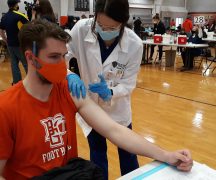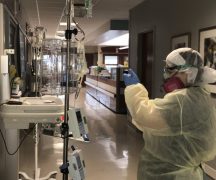Nearly 80% of the inmates in two Ohio prisons — some 3,500 people — have been diagnosed with COVID-19 since the virus that causes the disease was detected in the prison system March 29.
State records show both prisons house populations well beyond their design capacity, enabling the new coronavirus to spread among thousands of inmates and prison workers with breakneck speed.
At Marion Correctional Institution, 2,011 inmates of about 2,500 at the facility have tested positive for COVID-19, two of whom have died, as of Wednesday. At least 157 workers have been infected, one of whom has died.
The New York Times reported the prison, which was only built to house 1,655 inmates, is now the biggest viral hotspot in the U.S.
At Pickaway Correctional Institution, 1,555 inmates of roughly 2,000 inside are infected. Ten inmates have died from COVID-19, as of Tuesday. At least 73 employees are infected as well.
The facility was only built to house 1,328 inmates, according to planning documents from the Ohio Department of Rehabilitation and Corrections..
The two prisons house inmates at higher risk to complications from COVID-19, the respiratory disease caused by the new coronavirus.
A state prisons spokeswoman said Wednesday that Marion houses “a high number” of older individuals, many of whom have pre-existing health conditions. Pickaway houses the prisons’ long term care center, similar to a nursing home.
All told, nearly 3,800 of the 49,000 inmates in Ohio prisons have confirmed COVID-19 cases, as of Wednesday. Fourteen have died. Almost 320 employees of those facilities have confirmed cases as well, one of whom has died.
As of Wednesday evening, 93 inmates are hospitalized at the Wexner Medical Center at Ohio State University.
All told, about 30% of Ohio’s COVID-19 caseload traces back to the prison system.
Despite harboring populations above 150% of their design capacity, Marion and Pickaway are far from the most overcrowded prisons in Ohio.
Prisons like Lorain Correctional Institution (which houses 205% its design capacity), the Correctional Reception Center (190%) and Trumbull Correctional Institution (190%), are more overcrowded and have detected the virus among inmates and employees.
At the CRC, 68 inmates and eight workers have confirmed cases, as of Wednesday.
State health officials have conducted widespread testing at Marion and Pickaway, but Azurra Crispino, an activist whose husband is an inmate at Marion, said it’s a waste of time.
The strategy, she said, should focus on catching the first people infected and isolating them, not waiting until an outbreak spirals out of control.
“The testing needs to be done at these facilities that have fewer cases,” she said. “They need to assume that everyone at Marion and Pickaway are infected.”
She said her husband has told her about unrest in the dorms, a lack of access to soap, and prisoners left in the dark about their own health statuses.
Underscoring the difficulty of controlling the spread, Ohio Department of Health Director Dr. Amy Acton said this week that mass testing at the two hotspots have shown an unexpectedly large number of asymptomatic carriers, spreading the virus without knowing they’re infected.
While the death counts are low, she said Wednesday more are probably coming.
“We know, just by how this works, that the deaths will fall later,” she said.
Experts say prisons are dangerous sites for outbreaks, and Crispino wonders whether her husband would have access to quality care if complications arose from a COVID-19 infection.
“It is completely unclear to me, were my husband to experience respiratory distress, how he would be treated,” she said.
It’s not just advocates calling for action. State Supreme Court Justice Michael Donnelly authored a legal opinion last weekcalling for bold action to save inmates’ lives.
“The whole of Ohio’s government needs to take serious, unprecedented steps to prevent the catastrophe of unmitigated spread of COVID-19 to the tens of thousands of prisoners in Ohio as well as to the tens of thousands of people who are prison employees along with those living in the households of prison employees,” he said.
Similarly, the head of the union that represents prison workers accused the top state prisons official of negligence in her pandemic “throw-stuff-against-the-wall” response.
Gov. Mike DeWine has recommended the release of about 200 prisoners, roughly 100 of whom have been granted early release. However, the ACLU of Ohio is urging the release of thousands of inmates to keep prisoners safe from infection, hospitalization and possibly death.
Another Marion inmate, Matthew Redmeyer, who is about six years into a seven-year sentence, described a chaotic and frenzied ordeal as Marion staff tried — he says unsuccessfully — to keep infected inmates from the uninfected.
Besides the administrative problems, he echoed what advocates have been saying for months — social distancing is simply impossible in prisons.
“Our soap dispensers are not filled over the weekends and are frequently empty, our cleaning supplies haven’t been increased from pre-COVID amounts and constantly run out, and we are, of course, living on double racks three feet or less apart,” he said.
Redmeyer sent the messages through Jpay to Ohio Prisoners Justice League, an advocacy group, which provided them to The Ohio Capital Journal.
Video previously obtained from inside Marion shows despite statewide efforts to socially distance to curb the spread of the virus, the prison continued to hold scores of inmates in close quarter.
***
Also on Ohio Capital Journal.
Ohio Supreme Court: Previous sexual activity protected under rape-shield law
The Ohio Supreme Court ruled this week that previous sexual activity can’t be used as evidence against an accuser in rape cases.
In an opinion released Wednesday, the high court upheld the conviction of Cedric Jeffries, convicted of kidnapping and rape.
In the unanimous decision, the Supreme Court held that the state’s rape-shield law applies both to consensual and non-consensual sexual activity, and that the Eighth District Court of Appeals applied the law correctly. READ MORE
Jewish leader: response to Brenner part of ‘protocol’ on handling Ohio pols’ Nazi comparisons
When the anti-Semitic comments amplified by state Sen. Andrew Brenner were uncovered Wednesday morning, Howie Beigelman, the son of a Holocaust survivor, knew what to do.
He picked up the phone and called Brenner directly to talk about them.
This is the third such call the executive director of Ohio Jewish Communities has had to make in the past year or so. Inflammatory references to the Holocaust and Nazi Germany are common enough among Ohio politicians, in fact, that Beigelman has a stated plan of how to respond.
“Unfortunately,” he told the Capital Journal, “we have a protocol on this.” READ MORE





